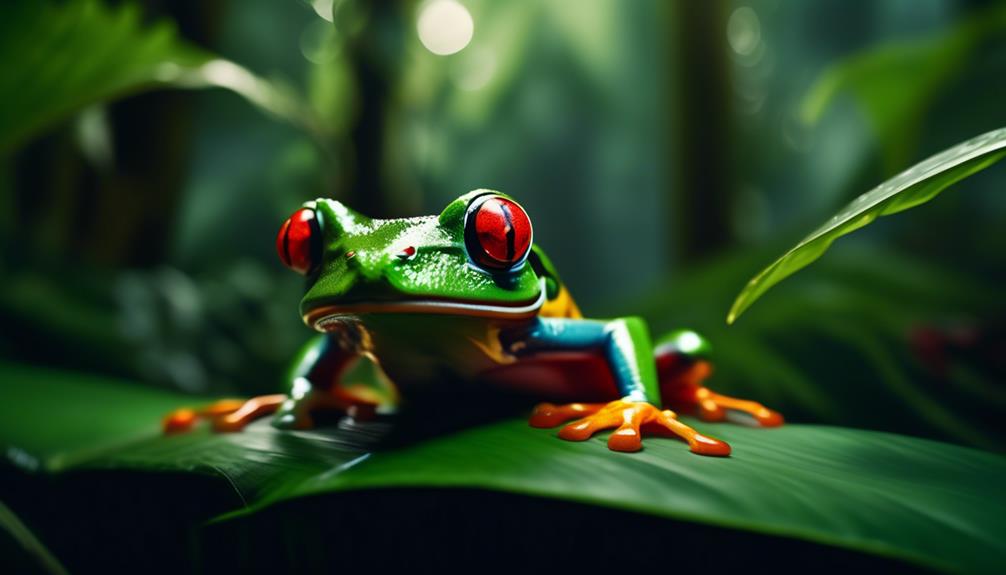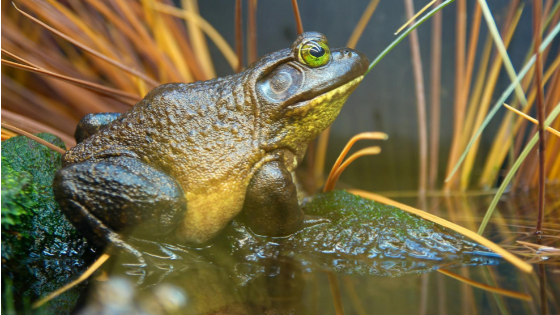
The red-eyed tree frog, a true marvel of nature, captivates the imagination with its vibrant green coloration and striking red eyes. This iconic species, known scientifically as Agalychnis callidryas, calls the rainforests of Central America and Mexico its home.
However, beneath its enchanting exterior lies a tale of vulnerability and threats that loom over its existence. The red-eyed tree frog faces a myriad of challenges, including habitat destruction, pollution, and the introduction of predators.
In this article, we will explore the remarkable world of this rainforest icon and delve into the pressing issues that threaten its survival.
Key Takeaways
- The Red-Eyed Tree Frog is a vibrant and visually striking species found in the rainforests of Central America and Mexico.
- Its habitat and physical characteristics make it an excellent indicator species for assessing the health of rainforest ecosystems.
- The frog’s population is threatened by various factors, including chemical contamination, the introduction of predators, and environmental changes caused by human activities.
- Conservation efforts, such as habitat protection, research, and awareness-raising, are crucial for the long-term survival of this iconic rainforest species.
Physical Characteristics of Red-Eyed Tree Frog
The physical characteristics of the Red-Eyed Tree Frog make it a striking and easily recognizable species in the rainforest ecosystem. With their bright lime green bodies, highlighted by hints of yellow or blue, these frogs are a sight to behold. Their most distinctive feature is their big bulging red eyes, which give them their name. This eye-catching trait serves as a defense mechanism, intimidating potential predators.
To further blend in with their leafy environment, they have green eyelids which help them camouflage. Additionally, they have white bellies and throats, with blue sides adorned with white borders and vertical white bars. These unique physical attributes not only make the Red-Eyed Tree Frog visually appealing but also help them survive in their natural habitat.
Habitat and Distribution of Red-Eyed Tree Frog

The Red-Eyed Tree Frog can be found in the lowlands and slopes of Central America and Mexico, inhabiting a variety of rainforest ecosystems. These vibrant frogs start their lives as tadpoles in temporary or permanent ponds, depending on water to keep their skin moist.
As they grow, they can be seen clinging to branches, tree trunks, and underneath tree leaves. As adults, they live in the canopy layer of the rainforest, where they find shelter and reproduce. Their habitat is crucial for their survival, as it provides the necessary conditions for their unique lifestyle.
However, the increasing destruction of rainforests and pollution pose a significant threat to their habitat and distribution. Conservation efforts are necessary to protect the Red-Eyed Tree Frog and preserve its role as a rainforest icon.
Diet and Feeding Habits of Red-Eyed Tree Frog

Red-Eyed Tree Frogs rely on a carnivorous diet to sustain their energy and nutritional needs. They are primarily insectivores, with a preference for crickets, flies, grasshoppers, and moths. These frogs have a unique feeding strategy where they wait patiently on leaves or branches, using their excellent camouflage to blend in with their surroundings. When an unsuspecting insect passes by, they swiftly extend their long, sticky tongues to capture their prey.
Occasionally, Red-Eyed Tree Frogs may also consume smaller frogs if they come across them. As tadpoles, their diet consists of fruit flies and pinhead crickets. Their carnivorous diet ensures that they obtain the necessary nutrients to survive and thrive in their rainforest habitat.
Threats to the Red-Eyed Tree Frog Population

As an indicator species for ecosystem health, the Red-Eyed Tree Frog population faces numerous threats that contribute to its decline in Central America and Mexico. These threats can be categorized into two main factors: human activities and environmental changes.
Human Activities:
- Chemical contamination: The use of pesticides, acid rain, and fertilizers in agricultural practices leads to water pollution and habitat destruction, directly impacting the survival of the frogs.
- Introduction of foreign predators: Non-native species such as snakes and rats, introduced either accidentally or intentionally, prey on the frog eggs, tadpoles, and adults, causing a significant decline in their population.
Environmental Changes:
- Increased UV-B exposure: The thinning of the ozone layer allows higher levels of harmful UV-B radiation to reach the rainforest, resulting in deformities and reduced survival rates among the frog population.
These threats highlight the urgent need for conservation efforts to protect the iconic Red-Eyed Tree Frog and its fragile rainforest habitat.
Importance of Red-Eyed Tree Frog as an Indicator Species

An invaluable ecological sentinel, the Red-Eyed Tree Frog serves as a critical indicator species for assessing the health of its rainforest ecosystem. As a species that depends on both terrestrial and aquatic environments, any changes or disturbances in these habitats can directly impact the survival and abundance of the Red-Eyed Tree Frog.
By monitoring the population and behavior of these frogs, scientists can gain valuable insights into the overall condition of the rainforest ecosystem. For example, the presence or absence of Red-Eyed Tree Frogs can indicate the availability of suitable breeding habitats and the quality of water bodies. Furthermore, their sensitivity to environmental changes, such as pollution and habitat degradation, makes them excellent bioindicators.
As such, protecting the Red-Eyed Tree Frog and its habitat is not only crucial for the survival of this iconic species but also for the preservation of the entire rainforest ecosystem.
Conservation Efforts for Red-Eyed Tree Frog

The preservation of the Red-Eyed Tree Frog and its rainforest habitat necessitates dedicated conservation efforts in order to safeguard the delicate balance of the ecosystem. To ensure the survival of this iconic species, the following conservation efforts are crucial:
- Habitat Protection:
- Establishing protected areas and reserves to safeguard the frog’s natural habitat.
- Implementing measures to prevent deforestation and habitat degradation, such as sustainable land-use practices and reforestation initiatives.
- Species Management:
- Conducting research on the frog’s population dynamics, behavior, and reproductive patterns.
- Developing captive breeding programs to increase their numbers and reduce dependence on wild populations.
These conservation efforts aim to mitigate the threats faced by the Red-Eyed Tree Frog, such as habitat loss, pollution, and the introduction of invasive species. By prioritizing the conservation of this species, we can contribute to the overall health and biodiversity of the rainforest ecosystem.
The Future of the Red-Eyed Tree Frog

Looking ahead, the conservation of the Red-Eyed Tree Frog is imperative for the long-term survival of this iconic rainforest species. Efforts must focus on protecting their natural habitat, reducing pollution and chemical contamination, and controlling the introduction of foreign predators. Additionally, raising awareness about the importance of preserving biodiversity and the role of the Red-Eyed Tree Frog as an indicator species for ecosystem health is crucial.
| Challenges | Strategies | Benefits |
|---|---|---|
| Habitat loss due to deforestation | Establishing protected areas and promoting sustainable land use practices | Preserving the unique ecosystem of the rainforest |
| Pollution and chemical contamination | Implementing stricter regulations on pesticide use and reducing industrial pollution | Ensuring the health and well-being of the frog population |
| Introduction of foreign predators | Implementing control measures and educating local communities about the impact of non-native species | Protecting the Red-Eyed Tree Frog from predation and maintaining its natural balance |
Frequently Asked Questions
How Do Red-Eyed Tree Frogs Use Their Startle Coloration as a Defense Mechanism?
Red-eyed tree frogs use startle coloration as a defense mechanism by suddenly opening their bright red eyes and flashing their vibrant colors, which startle predators and make them think twice before attacking.
What Is the Significance of the Red-Eyed Tree Frog’s Green Eyelids?
The green eyelids of the red-eyed tree frog serve as a camouflage adaptation, allowing it to blend in with the leafy environment of the rainforest. This helps protect the frog from potential predators by making it harder to detect.
What Other Predators Besides Foreign Predators Pose a Threat to the Red-Eyed Tree Frog Population?
Besides foreign predators, other threats to the red-eyed tree frog population include chemical contamination from pesticide use, acid rain, and fertilizers, as well as increased UV-B exposure from a weakened ozone layer. These factors contribute to the decline of this iconic rainforest species.
How Do Red-Eyed Tree Frogs Change Color According to Their Mood?
Red-eyed tree frogs change color according to their mood through a process called physiological color change. This is achieved by the dispersion or concentration of pigments in their skin cells, allowing them to display various shades of green, yellow, blue, or brown.
What Are the Specific Factors Contributing to the Decline in Amphibian Populations?
The decline in amphibian populations can be attributed to various factors such as chemical contamination from pesticide use, acid rain, and fertilizers, introduction of foreign predators, and increased UV-B exposure from a weakened ozone layer.
How Do Threats to the Red-Eyed Tree Frog Compare to Those of the Japanese Common Toad?
Threats to the red-eyed tree frog, such as habitat destruction and climate change, differ from those facing the Japanese common toad. While the red-eyed tree frog population is declining due to deforestation, the explosive breeding in Japanese common toads makes them vulnerable to road traffic and pollution.
Conclusion
In conclusion, the red-eyed tree frog is a captivating species that faces numerous threats to its population and habitat. From chemical contamination to foreign predators and UV-B exposure, these frogs are at risk of extinction.
As an indicator species, their decline serves as a warning sign for broader ecosystem health concerns. Conservation efforts are crucial to ensure the survival of this iconic rainforest species.
The future of the red-eyed tree frog depends on continued conservation efforts and the protection of its fragile habitat.



